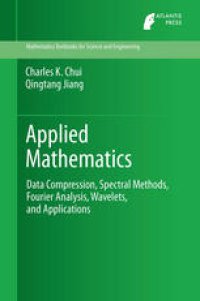
Ebook: Applied Mathematics: Data Compression, Spectral Methods, Fourier Analysis, Wavelets, and Applications
- Tags: Applications of Mathematics, Information and Communication Circuits, Statistics general, Computer Imaging Vision Pattern Recognition and Graphics, Engineering Design
- Series: Mathematics Textbooks for Science and Engineering 2
- Year: 2013
- Publisher: Atlantis Press
- Edition: 1
- Language: English
- pdf
This textbook, apart from introducing the basic aspects of applied mathematics, focuses on recent topics such as information data manipulation, information coding, data approximation, data dimensionality reduction, data compression, time-frequency and time scale bases, image manipulation, and image noise removal. The methods treated in more detail include spectral representation and “frequency” of the data, providing valuable information for, e.g. data compression and noise removal. Furthermore, a special emphasis is also put on the concept of “wavelets” in connection with the “multi-scale” structure of data-sets. The presentation of the book is elementary and easily accessible, requiring only some knowledge of elementary linear algebra and calculus. All important concepts are illustrated with examples, and each section contains between 10 an 25 exercises. A teaching guide, depending on the level and discipline of instructions is included for classroom teaching and self-study.
This textbook, apart from introducing the basic aspects of applied mathematics, focuses on recent topics such as information data manipulation, information coding, data approximation, data dimensionality reduction, data compression, time-frequency and time scale bases, image manipulation, and image noise removal. The methods treated in more detail include spectral representation and “frequency” of the data, providing valuable information for, e.g. data compression and noise removal. Furthermore, a special emphasis is also put on the concept of “wavelets” in connection with the “multi-scale” structure of data-sets. The presentation of the book is elementary and easily accessible, requiring only some knowledge of elementary linear algebra and calculus. All important concepts are illustrated with examples, and each section contains between 10 an 25 exercises. A teaching guide, depending on the level and discipline of instructions is included for classroom teaching and self-study.